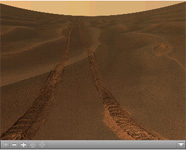
Click on the image for Opportunity's 'Rub al Khali' Panorama (QTVR)This panoramic image, dubbed "Rub al Khali," was acquired by NASA's Mars Exploration Rover Opportunity on the plains of Meridiani during the period from the rover's 456th to 464th sols on Mars (May 6 to May 14, 2005). Opportunity was about 2 kilometers (1.2 miles) south of "Endurance Crater" at a place known informally as "Purgatory Dune."
The rover was stuck in the dune's deep fine sand for more than a month. "Rub al Khali" (Arabic translation: "the empty quarter") was chosen as the name for this panorama because it is the name of a similarly barren, desolate part of the Saudi Arabian desert on Earth.
The view spans 360 degrees. It consists of images obtained in 97 individual pointings of the panoramic camera. The camera took images with five camera filters at each pointing. This 22,780-by-6,000-pixel mosaic is an approximately true-color rendering generated using the images acquired through filters admitting light wavelengths of 750, 530, and 480 nanometers.
Lighting varied during the nine sols it took to acquire this panorama, resulting in some small image seams within the mosaic. These seams have been smoothed in sky parts of the mosaic to better simulate the vista that a person would see if able to view it all at the same time on Mars.
Opportunity's tracks leading back to the north (center of the panorama) are a reminder of the rover's long trek from Endurance Crater. The deep ruts dug by Opportunity's wheels as it became stuck in the sand appear in the foreground. The crest and trough of the last ripple the rover crossed before getting stuck is visible in the center. These wind-formed sand features are only about 10 to 15 centimeters (4 to 6 inches) tall. The crest of the actual ripple where the rover got stuck can be seen just to the right of center. The tracks and a few other places on and near ripple crests can be seen in this color image to be dustier than the undisturbed or "normal" plains soils in Meridiani. Since the time these ruts were made, some of the dust there has been blown away by the wind, reaffirming the dynamic nature of the martian environment, even in this barren, ocean-like desert of sand.

 Planetary Data System
Planetary Data System













